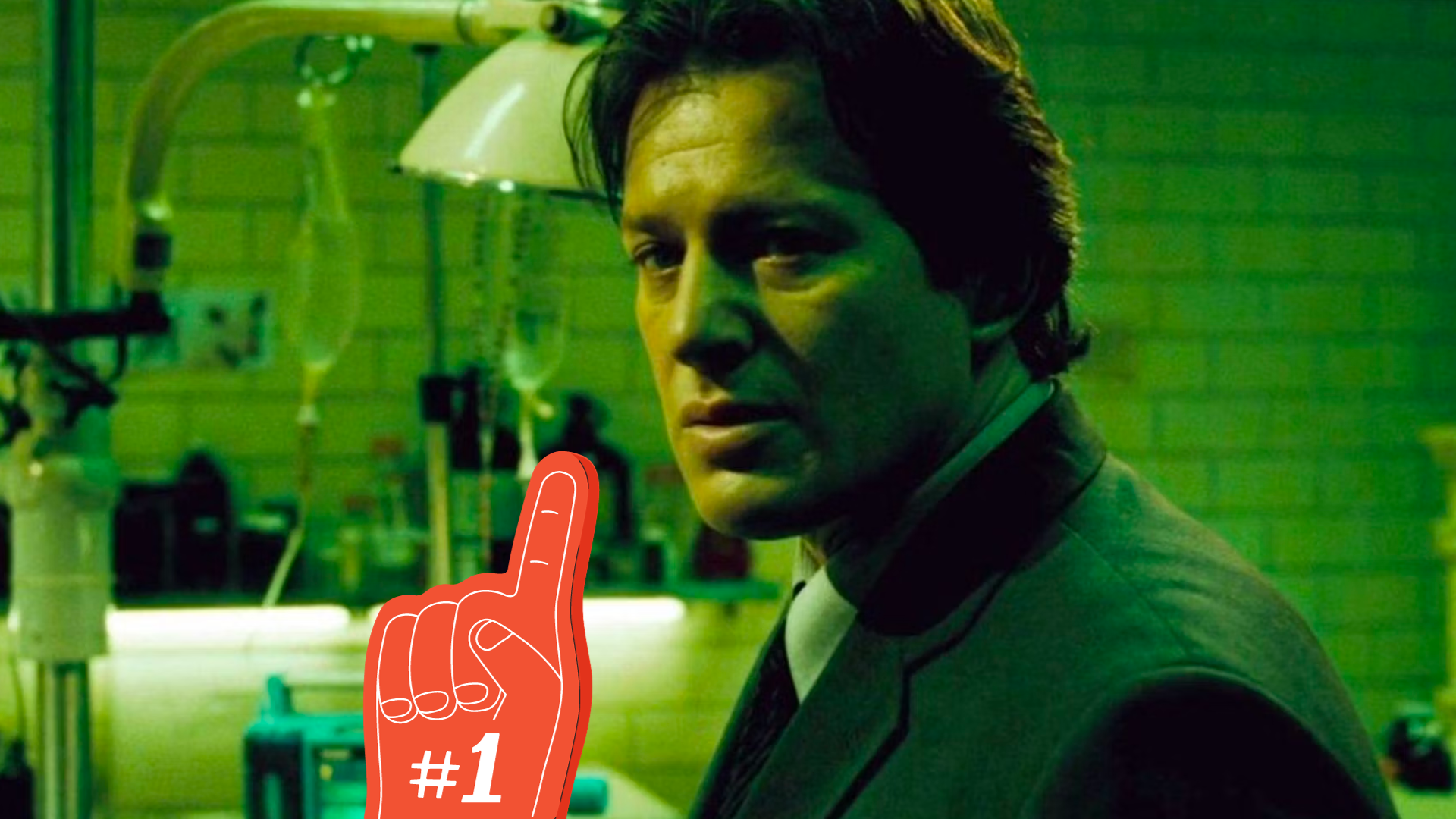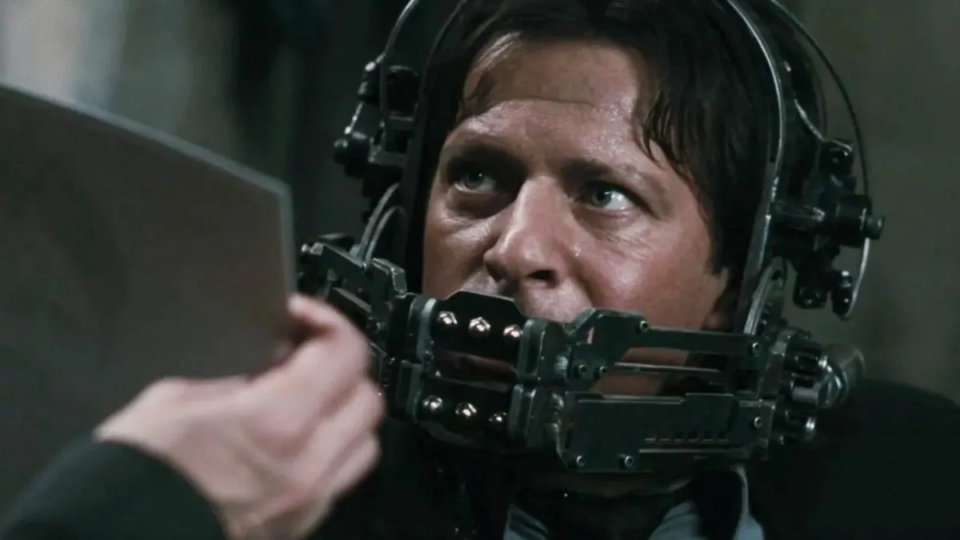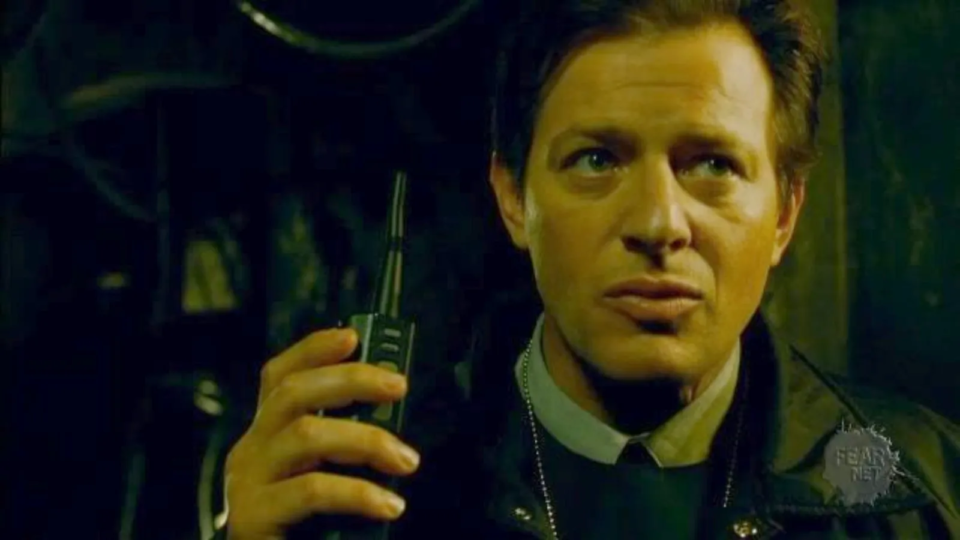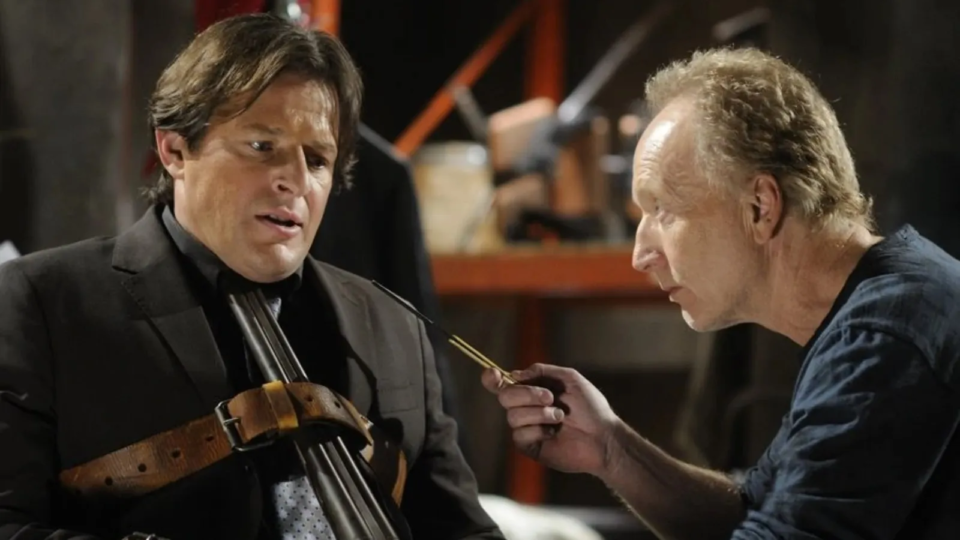Detective Hoffman Was Always Jigsaw’s Greatest Apprentice

Editor’s note: This piece features heavy spoilers for every Saw movie, including Saw X.
A consistency you’ll find among some of the most successful horror franchises is that of a central antagonist leading the terror charge. A Nightmare on Elm Street is haunted by dreamscape slasher Freddy Krueger. Pinhead is the prickly face of Hellraiser. Chucky just about speaks (and stabs) for himself. Every once in a while, however, you’ll have a rogue entry like Friday the 13th: A New Beginning or Halloween Ends (a good movie, actually), where the main slasher takes a bit of a back seat in favor of a rising evil.
Other times you’ll have something like Scream, where the faces of the main threat take shifts behind a piece of iconography like Ghostface. Sometimes long-running franchises need to shake things up and see if there’s room to expand beyond its initial killer. In the case of Saw, this method oddly proved to be one of the keys to its success.
The Saw-ga Of It All
When James Wan’s inaugural feature was released to an unsuspecting Sundance audience, Tobin Bell’s reign as John Kramer—aka the Jigsaw killer—became an overnight horror icon. His menacing voice became synonymous with intricate puppetry, threatening cassette tapes, and Rube Goldberg monstrosities. Who could forget the initial shock of watching that supposedly dead guy rise off the floor to reveal that he was the sick mastermind behind the bathroom from hell? It made a great hook for a sequel, too. I wanted to know how Kramer ran his games when he wasn’t incapacitated. Saw II once again kept Kramer largely in one spot, opting instead to have the audience face him and his barbarous beliefs up close.
As we all know though, at the end of Saw III, Kramer meets his grisly end upon issuing one final in-person test to game participant Jeff Denlon (Angus Macfayden). Unlike Jason Voorhees, who could be brought back from the grave, Kramer is nothing more than a cunning cancer patient who could never escape a power saw to the throat. We learn in Saw II that former trap victim Amanda (the always amazing Shawnee Smith) had not only survived the Reverse Bear Trap, but became a devoted follower of Kramer’s teachings in the process. But with Kramer’s fatal failure also came Amanda’s. Saw III was intended as the finale, with seemingly no one left to carry on the games. But if you’re the head of Lionsgate and your horror movie just made $164.9 million on a $10 million budget, the games are most definitely not over. So what do you do?
Saw Apprentices Are Like Pokémon
As the series progressed, more and more names were brought into the Jigsaw fold, which provided a fascinating angle for these stories to continue. Kramer’s whole deal was acting as this disfigurement guru, of which the reformed would flock to his ideals after having learned a literal life lesson. It’s become commonplace for the big twists of these movies to reveal a new player of their grotesque games that was hiding in plain sight—Amanda Young, Logan Nelson (Matt Passmore), Dr. Lawrence Gordon (Cary Elwes) and occasionally Jill Tuck (Betsy Russell). We all know by now that Jigsaw basically collects apprentices like Pokémon.

Saw presents an example of a franchise where, despite the pullback of its central killer, the fan base largely accepted newcomers into the fold. Kramer could still exist in the margins through flashbacks central to the game’s narrative. For the most part, each of these disciples brought a fresh perspective on the Jigsaw legacy (maybe not Logan), yet it’s Detective Mark Hoffman (Costas Mandylor), who presented the most interesting understudy to Kramer.
Do You Like How Brutality Feels, Mark?
From Saw IV to Saw 3D, Det. Hoffman became the series’ main antagonist. He was initially a Metropolitan police officer of the enigmatic Saw City, who found himself spiraling down a dark path. The character’s first appearance is just one scene in Saw III as a background detective overlooking the aftermath of the Classroom Trap, which is hilarious in hindsight given how absolutely guilty he looks just being there. The character received his name as a touching tribute to producer Gregg Hoffman, who sadly passed away in 2005. He does heartwarmingly receive posthumous credits on every entry from Saw III onwards alongside producers Mark Burg and Oren Koules.
Prior to his apprenticeship, Det. Hoffman was the perfect candidate for Kramer to latch onto. The first glimpse we get of his work in the field is protecting then-Officer Daniel Rigg (Lyriq Bent) after an unlawful altercation with a parent accused of domestic violence. Hoffman signs an affidavit saying that the abusive father struck first. While we later come to learn that Rigg’s instincts were correct, the actions taken in a position of power like his could easily bring him down and derail a possible conviction. It’s the first canonical instance of Hoffman’s ability to twist the truth in favor of his dedication to the unspoken cop brotherhood.

Jigsaw Doesn’t Take Kindly To Police
Despite what Spiral claimed, Jigsaw was undoubtedly an ACAB supporter. In his eyes, they are either ineffective at their job, destructive to their own lives, or pawns in his games. Look no further than Homicide Detective turned human watermelon Eric Mathews (Donnie Wahlberg). In Saw II, we learn that he casually doled out acts of police brutality, in addition to forging evidence that sent people like Amanda back to prison on bogus charges. Kramer doesn’t trust the police to hold themselves accountable to the standards of their positions, so he does it for them. One of his rationales for placing people in these traps is that he believes the current form of rehabilitation among criminals is broken, of which he’d be correct. Things get a little murky, however, when that supposed rebirth comes about through various torture methods. That Jigsaw sure is a complicated fellow.
Where Hoffman was your average scuzzy cop prior, the death of his sister Angelina (Sarah Power) at the hands of her abusive boyfriend Seth Baxter (Joris Jarsky) is what ultimately transforms him into the series antagonist we know and fear. Angelina’s death pushed him to embrace his darker tendencies under the badge, such as shooting an unarmed homeless man in the back. Despite a police brutality report filed by his former partner Matt Gibson (Chad Donella), Hoffman was unsurprisingly gifted with a promotion.
Hoffman’s swift acquittal likely pushed him to see if he could push the envelope any further. At this point, Kramer had notoriously gone through a number of traps already, and Baxter’s technicality-based early release gave Hoffman the perfect opportunity to dispense his own brand of vengeance. Somewhere along the line, Hoffman must have secured a secret engineering degree because the Pendulum Trap is some impressive 17th-century shit. But unlike a traditional Jigsaw trap designed by Kramer, Baxter was always going to lose in spite of crushing both of his hands. Rehabilitation? Never heard of them.
While never explicitly stated, the tattoos on Baxter’s body indicate that he at least has ties to neo-Nazi organizations. It walks that line where a cop abuses his power, but there’s also some satisfaction in watching a Nazi painfully leave this world. But in the eyes of Jigsaw, not only was this a flat-out murder, but an amateur misuse of his methods. As you’re quick to learn with this series, if you screw with Jig-fucking-saw, you’re not going to get away with it.
We Bought a Hoffman
Saw V can often be a scapegoat as one of the series’ worst sequels. But, I’ve always appreciated it for giving more insight into Hoffman’s part in the games. The ending of Saw IV saw the shady detective revealed to Rigg as the secret mastermind. It continues the series tradition of promoting actors with each film. Hoffman goes from background cop in Saw III, to surprise apprentice in Saw IV, to main antagonist in Saw V and beyond, and I think that’s pretty cool. But what’s not very cool is impersonating Jigsaw himself, especially with such an inferior pendulum to improperly place on the serial killer’s resume. It really shows how petty Kramer is that he almost seems more annoyed that his setup was amateur garbage.
The first standoff between these two antagonists is a series highlight, as it demonstrates their glaring flaws in 4K. Hoffman doesn’t even try to hide his reasoning for getting someone killed, while Kramer does. It’s what always made Jigsaw an interesting villain. He hides murder behind his warped rationale for putting people through these tests. “Killing is distasteful…to me,” yells a disgusted Kramer. It doesn’t take much investigation of past series events to understand that, even when Jigsaw doesn’t directly end his victims’ lives, he still forces them into a nearly unwinnable situation that results in either traumatic bodily dismemberment or death.
From this moment, Hoffman is offered a life-altering choice: either he can learn how to perform his methods the “correct” way or have his little stunt exposed to the world. It’s less of a genuine onboarding contract than blackmail disguised as retribution. Kramer basically instructs him to do the work like the leader of a school project who will narc to the teacher unless he puts in his fair share of effort. It should also be noted that in Saw V, you can see that Hoffman graduated from Renfield University as if that doesn’t hilariously spell out his fate.
Who Is Your Lackey and What Does He Do?
So, you’ve become an accomplice to Jigsaw. What next?
What made Hoffman so interesting in my eyes is how resourceful he is, both as Kramer’s pupil and a crooked cop. He was undoubtedly one of the game maker’s most valuable assets. Prior to Hoffman’s introduction, you almost have to laugh at how someone like Kramer could possibly know about Eric’s home life or Jeff’s revenge path. But with a detective giving him information like a twisted police captain, a part of these hilariously convoluted plans start to make sense. Without the detective, Kramer wouldn’t have amassed nearly enough information to trap his game participants.
The most obvious example of this happens in Saw X, where Kramer calls upon Hoffman to receive information on Cecilia (Synnøve Macody Lund) and her faux medical crew. It’s what saves him in the end, given that Parker (Steven Brand) is meant to be this wild card that could throw the whole game into question. But with Hoffman doing the research, he’s able to go into it with the knowledge that Parker wasn’t a patient of Cecilia, but a hidden accomplice to her scheme.
Hoffman Vs. Amanda
As of Saw X, Hoffman has interacted with just about every apprentice in some form or another. It’s Amanda though, who offers the most interesting back and forth. Chronologically, he was a human puppet long before she was. But it’s clear that Kramer appears to show more favoritism towards Amanda. I keep thinking back to the flashback in Saw VI where we see the trio interacting as if they were in a workplace comedy. The construction of this towering torture device is casually talked about as if they were mechanics working on a car. It’s a shame we didn’t get to see more interactions between Hoffman and Amanda. Mandylor and Smith share a surprisingly fun sibling energy, as they snip at one another over the little things. It makes you wonder what a game would look like if Kramer made them work together.
On his own, Hoffman was able to replicate a traditional Jigsaw game. The commonality between them is the choice of one or the other. In Saw IV, Rigg could either let the test subjects go it alone or face consequences. Saw V saw a room of strangers battling amongst themselves to see who would make it to the end, even though they all could have survived together. Kramer always had a thing for withholding critical information until the worst possible opportunity. By the time you get to Saw VI, you would think that Kramer would have abhorred allowing someone to die in order to move forward. But the test of William Easton (Peter Outerbridge) shows him indulging in it. Hypocrisy, thy name is Jigsaw.
Failure of the Game Maker
Every Saw film proves in its own way how Jigsaw’s entire mission is a failure. Dr. Gordon never comes back for Adam. Mathews employs police brutality, which leads to Kramer’s escape. Amanda falls prey to a manipulative cult leader, who trusts her so much that he continually feels the need to test her, rather than actually getting her professional treatment. The Abbott family was given a chance to forgive the man who denied their father health insurance and instead turned Rodrick Rules into a murderer. Hoffman, the last one standing, burns everything down.
Amanda applied herself to try and be Kramer’s equal. She was proficient at capturing test subjects, as well as learning to build her own contraptions (The Angel Trap, Shotgun Collar). Unlike the gruff detective, she willingly joined Kramer’s crusade with the belief that his games will all make sense in the end. Kramer looked to her as his true protege, but Amanda possessed a fatal flaw: she couldn’t let her test subjects survive. Even if they passed their game, she would find a way to discard them, or at least try to. She possessed the drive to go all the way with Kramer’s vision, but much like the most effective cult leaders, he manipulated her up until the very end. Rather than helping her find peace, he threw her into a series of vague riddles and tests.

Is There Truly Any Winner To Jigsaw’s Games?
Throughout the series, Kramer propped himself up as someone to learn from. He demonstrated his philosophy on making the most of your life to anyone who would listen. Murder is the worst act you could commit in his eyes, and has the nerve to claim that he’s never murdered anyone. Lest we forget when his throat-sliced Sgt. Rigg (Danny Glover) with a hidden cloak blade in order to make his escape. I’ve already established how his philosophy is a crock, but there’s something else to Kramer that I feel adds another dimension to his whole operation.
I’ve always suspected that Kramer largely doesn’t want his victims to pass their test, and the ones that do, he manipulates for his own personal gain. There’s a moment in Saw X that confirmed my suspicions, where Kramer catches a custodian ready to swipe the valuables of a comatose man. The next thing we know, said nurse is found inside the eye tube trap featured on that awesome teaser poster. It’s not until eyes have been forcibly suctioned out of that dude’s cranium that we realize it was all in his imagination. If Kramer truly wanted this man to learn a valuable lesson under his mantra, he would have wanted him to win. But instead, the perspective of a professional sadist speaks volumes. When Jeff fails his test in Saw III, there’s even a sadistic grin on his face on his way out the door.
If Hoffman Only Had A Heart
I believe a lot of that rubs off on Hoffman to not only have a violent cop believing that the games work, but has essentially given a known killer the drive to push it even farther and not get caught. Jigsaw believed that Hoffman contorted his beliefs when he understood them painfully clearly. Reflect on that flashback in Saw VI when Hoffman is helping build the Rack. He tosses the game’s participant Timothy Young (Mpho Kaoho) out of a wheelbarrow onto the dirty floor, which catches Kramer’s attention. “That’s a human being,” says the very same Kramer who leaves Timothy’s fate not in his own hands, but in someone else’s.
Even more so than Amanda, I was always fascinated by the dichotomy of what Kramer taught Hoffman, as opposed to how he perceived his teachings. His first official ride-along is in capturing/testing Paul (Mike Butters), the suicidal man later found dead towards the beginning of the original Saw. During the flashback in Saw V, Hoffman says he was anticipating the feeling of remorse, to which Kramer tells him “the heart cannot be involved” and that “emotionally, there must be nothing there,” effectively giving him permission to watch his handiwork through the voyeuristic lens of a shark.
I love the scene in Saw VI where Hoffman goes to visit Flesh Trap champion Simone (the astounding Tanedra Howard) in the hospital and asks her if she learned anything from her experience. In possibly the most relatable reaction to surviving a Jigsaw trap, she pointedly asks him what she’s the fuck she’s supposed to learn from an act of forced mutilation under pressure. In the end, no one really does, and if they do, they don’t live to build upon their sick lessons.
Hoffman: The Judas of Saw
I believe Hoffman has always surpassed Kramer as the most honest game engineer. For example, these two build their first traps as a means for the people who caused the death of a loved one, and only one of them owns up to their part in its unfair advantage.
Kramer fostered an environment where he was not only in peril from the killers he emboldened, but they weren’t safe from one another. Where we initially believe that Amanda killed Lynn Denlon (Bahar Soomekh) out of jealousy in the way Kramer looks at her, we find out in Saw VI that Hoffman had blackmailed her into failing her test. If she didn’t kill Lynn, Hoffman would tell Kramer about her presence at the scene of Jill’s miscarriage. He essentially sets the events in motion that led to Amanda and Kramer’s death, therefore freeing himself from the shackles of his obligation. It was drilled into him that the games couldn’t be personal. Yet you only have to look at the legacy Kramer built to see how absolutely personal every part of it was, especially in his pointed efforts towards the parasitic health insurance industry.
Intimidation, Thy Name is Mandylor
Costas Mandylor’s quietly sadistic performance made him a more than suitable villain replacement whenever the series’ horror maestro took a backseat. Some have described his acting as wooden and stilted, but I see something different. There’s a stoic menace that shines through his physicality, even in the worst of these movies. It plays a large part in announcing his presence. Make no mistake, Mandylor is built. Amanda and Kramer were brains, not brawn, allowing him to fill that slot perfectly.
Behind Mandylor’s calm gaze lies this simmering beast that’s always on the verge of a rampage. He’s relatively good at keeping himself under control and being able to think on the fly. Hoffman’s two-decade stint on the force has given him ample opportunities to hide his true intentions whenever he feels that someone is on to him like Special Agent Peter Strahm (Scott Patterson). A lot of Saw V is those two playing this game of cat and mouse and body crusher. But when he’s cornered, he transforms into the villain Kramer could never be. You only have to look at his greatest test in Saw VI.
The Hoffman Precinct Massacre
With Hoffman having successfully placed the blame on Strahm, he’s blindsided not only by the difference in the puzzle pieces removed from people’s bodies, but the tape from Baxter’s trap. You can always tell which tapes were made by Hoffman, as they usually sound deeper than anything Kramer ever made. We know that he’s going to get caught by Special Agents Erickson (Mark Rolston) and Perez (Athena Karkanis). It’s mostly just a matter of when the lightbulb is gonna go off.
Kevin Greutert does an excellent job of having the precinct technician descramble the tape, while Erickson and Perez circle Hoffman like hungry sharks playing with their food. “Right now, you’re feeling helpless” plays on a loop, as it accurately reflects Hoffman’s internal monologue as he’s being bested by his co-workers. It’s an exceptionally tense sequence that blows up at the moment the killer’s voice can be heard in full clarity. I love how, for the first time, we see Hoffman going into berserker survival mode, killing everyone in the room in just under a minute. It shows how ruthless he can be in such a short amount of time. When Dr. Gordon (Cary Elwes) chains him up in the bathroom, he doesn’t waste a second reaching for the saw to do what needs to be done.
One Unstoppable Slasher Villain
Even after all of that, Hoffman isn’t so much tested, as he is punished for the failure of Jigsaw’s game. “If a subject services my method, he or she is instantly rehabilitated,” says Kramer during their first meeting. Circle back around to the opening of Saw 3D where Hoffman wins his freedom. He demonstrates that he wants to live, but utilizes his new lease on life by opting to murder Jill for sneaking the Reverse Bear Trap 2.0 on him. This is where Mandylor really plays up Hoffman as an unstoppable slasher villain. Say what you will about this mess of a film, but the one thing that always brings it to life, however brief, is Hoffman’s taking out the Saw City precinct with the fury of Michael Myers. He’s a legitimately threatening villain.
I practically lit up seeing him for that brief appearance at the end of Saw X. After being away for 13 years, just those few moments show that Mandylor’s still got it. Given how much of a success the film has turned out to be, it wouldn’t surprise me if we get to see more of Jigsaw’s bestest boy somewhere down the line.
Categorized:Editorials

